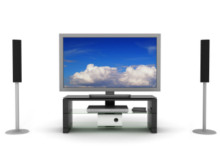
Discs.net
The Different Types of Discs
Blu-ray Discs

Blu-ray discs can store much more data than
DVDs...so they can give viewers a much
sharper image, even on large screens.
The Blu-ray Disc (BD) it like its predecessors, DVD and CD, but uses a much smaller wavelength (405nm compared to the 650nm used by DVDs and 780nm used by CDs). As such, the laser used to read Blu-ray discs can see smaller tracks and the tracks don't need as much space between each other.
Hence, the Blu-ray discs hold more than 5 x as much data as a DVD. And the manufacturers have projects underway to create stable 4, 6, and 10 layer Blu-ray writeable discs now...making data storage easier and cheaper than ever.
The main hurdle that Blu-ray discs faced when they were first created was the competition from HD-DVDs. While Blu-ray was backed by Panasonic, Samsung, Philips, and (most notably) Sony. The HD-DVD format was backed by Toshiba, Microsoft, Intel, RCA, and a few other big players.
While some of studios had been sometimes lining up on one side or the other, most had been releasing (or had plans to release) their films in both formats...not eager take sides until a clear 'victor' in the high-def market was visible.
But then in January of 2008, Warner Brothers announced that they would phase out their HD-DVD support. Other studios followed their lead.
Then the retail stores began to either push the Blu-ray format, or stop carrying HD-DVD formats altogether. Finally, in February 2008, Toshiba announced that they would stop developing the HD-DVD format. And Blu-ray discs had won the same sort of victory that VHS had won over Beta.
Click on the next arrow to see some related links, or


 Related Links
Related Links Related Videos
Related Videos Contact us
Contact us Link to us
Link to us
